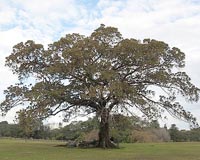 |
Dallas (UPI) Nov 12, 2009 A U.S. paleontology student says he has determined central Africa's tropical Congo Basin was arid and treeless during the Late Jurassic period. Southern Methodist University doctoral student Timothy Myers said he used geochemical soil analysis to discover the new paleoclimate data. He said the Congo Basin that today has a massive and lush tropical rain forest was far different 150 million to 200 million years ago when Africa and South America were part of the single continent Gondwana. Myers said the soil analysis showed the Congo Basin at that time was arid, with only a small amount of seasonal rainfall and few bushes or trees. "There aren't a whole lot of terrestrial deposits from that time period preserved in Central Africa," Myers said. "Scientists have been looking at Africa's paleoclimate for some time, but data from this time period is unique." He said there are several reasons for the scarcity of deposits, including ongoing tribal armed conflict that makes it difficult and challenging to retrieve them. And the area's modern thick vegetation, humid climate and continual erosion prevent the preservation of ancient deposits. Myers' research was based on a core sample taken from a depth of more than a mile by an oil and mineral exploration team. He presented his research last month in Portland, Ore., during the annual meeting of The Geological Society of America.
Greenpeace activists demand US action on deforestation Fifty activists from a dozen countries, including major greenhouse gas emitters the United States and China, also unfurled a massive yellow banner with a message for US President Barack Obama. "Obama: you can stop this," it read, ahead of the US president's visit to the region at the weekend for a summit of the Asia-Pacific Economic Cooperation forum in Singapore. "Greenpeace is sending President Obama an urgent call to action from the frontline of climate and forest destruction," Greenpeace USA forest campaigner Rolf Skar said. "He has promised to take decisive action on climate change, yet with just weeks left before December's critical UN climate summit, his administration is actively undermining and stalling global climate change negotiations." The Copenhagen summit has been convened to seal a treaty to succeed the Kyoto Protocol, whose obligations to cut carbon emissions expire in 2012, but there is little hope of agreement due to long-standing differences between rich and developing countries over who should bear the burden of lowering emissions. Indonesia is the third biggest emitter of greenhouse gases blamed for global warming, after China and the United States, and 80 pecent of its emissions are the result of deforestation. The clearing and burning of Indonesia's peatlands account for four percent of total global emissions, according to Greenpeace. The protest was staged in the Kampar peninsular, in Sumatra island's Riau province, where a major peatland forest is under threat from logging concessions and clearing for palm oil plantations. Ignoring Greenpeace's calls for a logging moratorium, the Southeast Asian archipelago continues to shred its forests -- home to rare species such as tigers, elephants and orangutans -- faster than anywhere else in the world. "Indonesia is climate change's 'ground zero'," Greenpeace Southeast Asia campaigner Bustar Maitar said. "Stopping forest destruction here and around the globe is not only one of the quickest and most cost effective ways to combat climate change but is essential in order to avert runway climate change in our lifetime." Share This Article With Planet Earth
Related Links Forestry News - Global and Local News, Science and Application
 Wasps give hope for vanishing tree species
Wasps give hope for vanishing tree speciesLeeds, England (UPI) Nov 11, 2009 British scientists say they've found fig wasps can travel about 100 miles in fewer than 48 hours, transporting pollen 10 times farther than any other insect. University of Leeds scientists said fig wasps travel such distances in search of trees to lay their eggs -- and that offers hope that trees pollinated by similar creatures have a good chance of surviving if they become isolated ... read more |
|
| The content herein, unless otherwise known to be public domain, are Copyright 1995-2009 - SpaceDaily. AFP and UPI Wire Stories are copyright Agence France-Presse and United Press International. ESA Portal Reports are copyright European Space Agency. All NASA sourced material is public domain. Additional copyrights may apply in whole or part to other bona fide parties. Advertising does not imply endorsement,agreement or approval of any opinions, statements or information provided by SpaceDaily on any Web page published or hosted by SpaceDaily. Privacy Statement |